Economics for Business: Elasticity, Trade, and Protectionist Policies
VerifiedAdded on 2023/05/28
|11
|2168
|481
Essay
AI Summary
This economics assignment addresses two key questions. The first question delves into the concept of price elasticity of demand, identifying and explaining the factors that influence it, such as the availability of substitutes, the time period considered, and the nature of the good (necessity vs. luxury). It illustrates these factors with examples from media reports. The second question examines the potential impact of President Trump's protectionist policies, including tariffs, on the Australian economy. It analyzes the advantages and disadvantages of protectionism, considering concepts like comparative advantage and potential trade wars. The assignment uses real-world examples to support the analysis and evaluate the economic consequences of these policies on both consumers and producers, exploring the potential for decreased demand, higher prices, and impacts on GDP and employment.
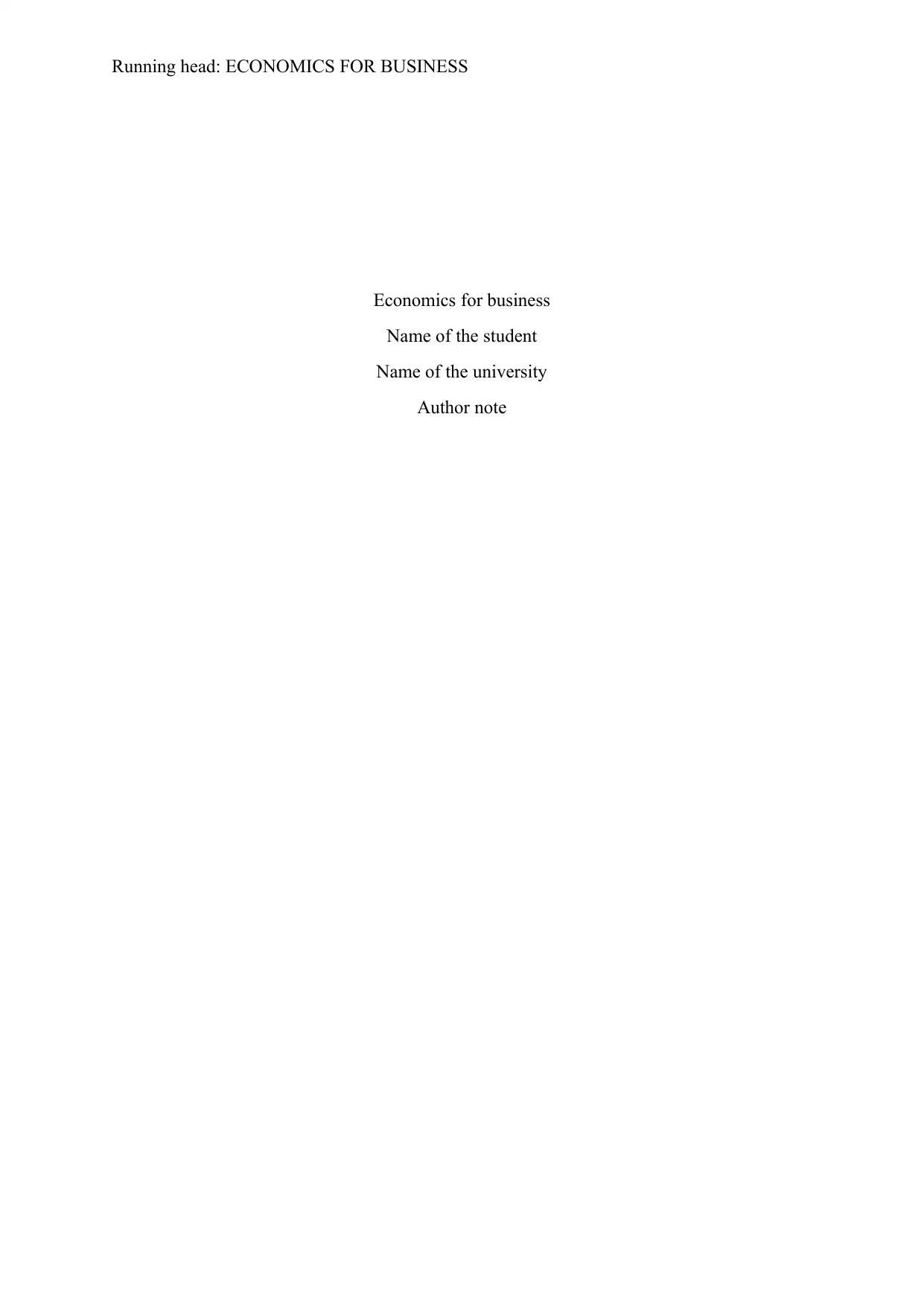
Running head: ECONOMICS FOR BUSINESS
Economics for business
Name of the student
Name of the university
Author note
Economics for business
Name of the student
Name of the university
Author note
Paraphrase This Document
Need a fresh take? Get an instant paraphrase of this document with our AI Paraphraser
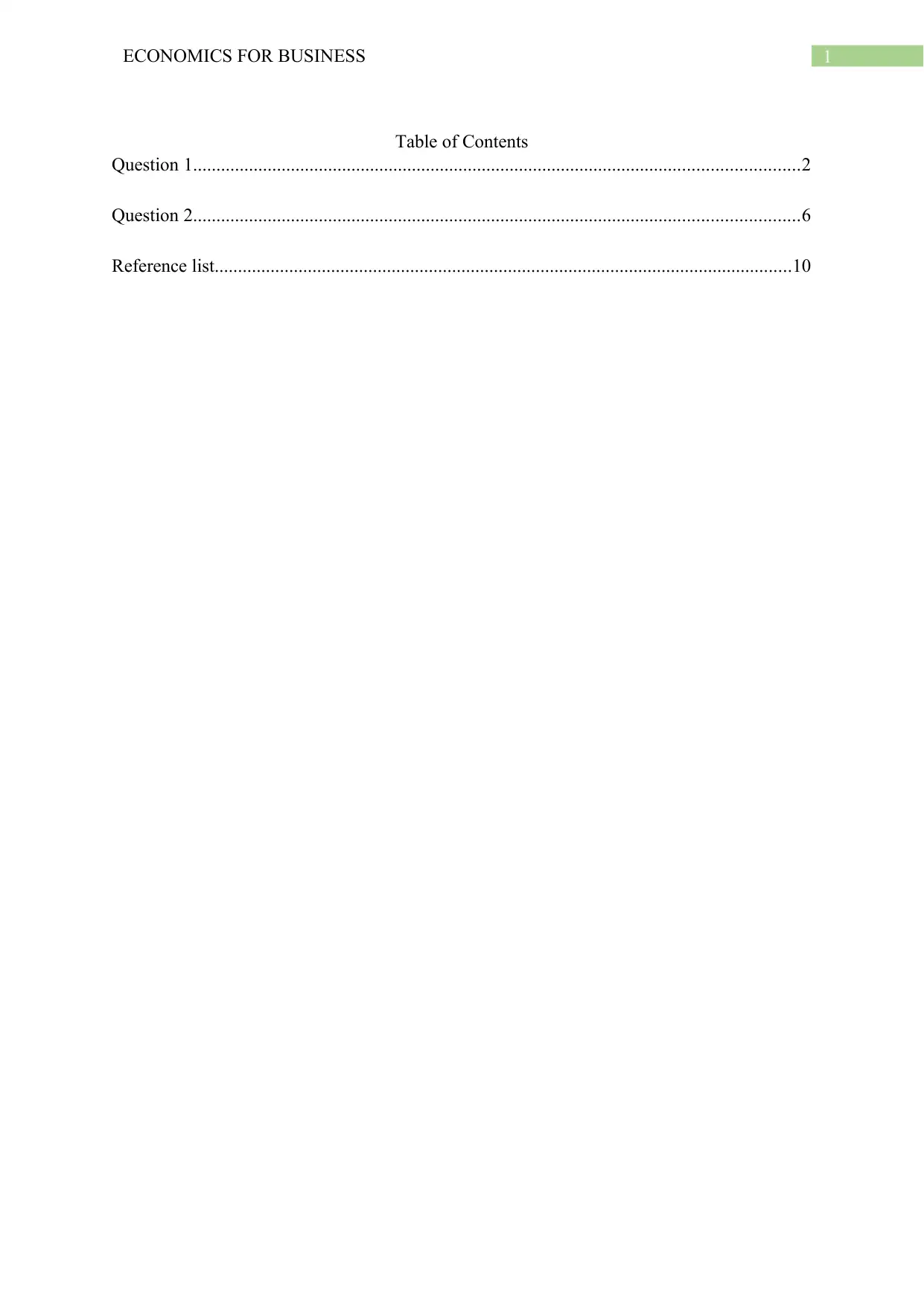
1ECONOMICS FOR BUSINESS
Table of Contents
Question 1..................................................................................................................................2
Question 2..................................................................................................................................6
Reference list............................................................................................................................10
Table of Contents
Question 1..................................................................................................................................2
Question 2..................................................................................................................................6
Reference list............................................................................................................................10
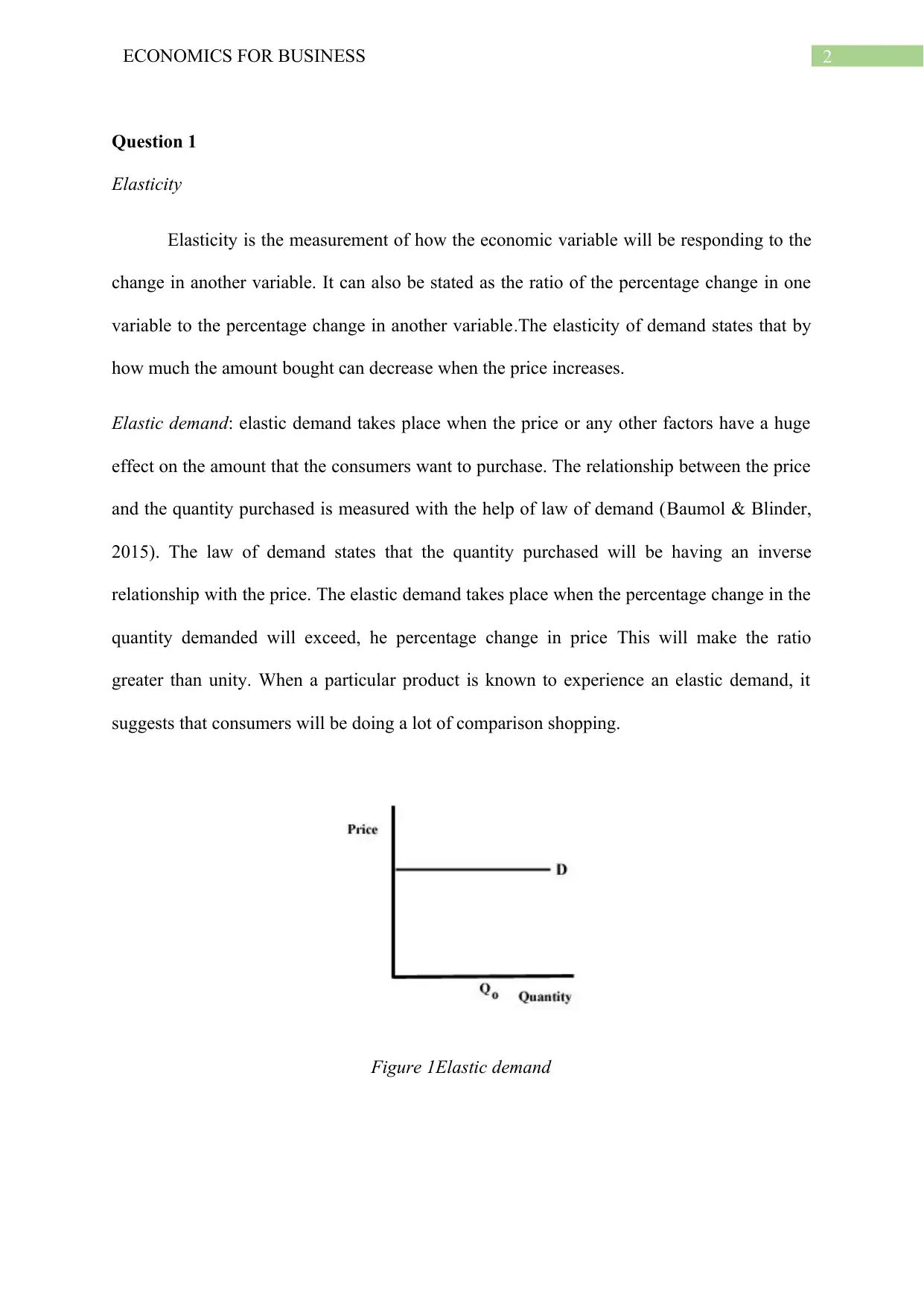
2ECONOMICS FOR BUSINESS
Question 1
Elasticity
Elasticity is the measurement of how the economic variable will be responding to the
change in another variable. It can also be stated as the ratio of the percentage change in one
variable to the percentage change in another variable.The elasticity of demand states that by
how much the amount bought can decrease when the price increases.
Elastic demand: elastic demand takes place when the price or any other factors have a huge
effect on the amount that the consumers want to purchase. The relationship between the price
and the quantity purchased is measured with the help of law of demand (Baumol & Blinder,
2015). The law of demand states that the quantity purchased will be having an inverse
relationship with the price. The elastic demand takes place when the percentage change in the
quantity demanded will exceed, he percentage change in price This will make the ratio
greater than unity. When a particular product is known to experience an elastic demand, it
suggests that consumers will be doing a lot of comparison shopping.
Figure 1Elastic demand
Question 1
Elasticity
Elasticity is the measurement of how the economic variable will be responding to the
change in another variable. It can also be stated as the ratio of the percentage change in one
variable to the percentage change in another variable.The elasticity of demand states that by
how much the amount bought can decrease when the price increases.
Elastic demand: elastic demand takes place when the price or any other factors have a huge
effect on the amount that the consumers want to purchase. The relationship between the price
and the quantity purchased is measured with the help of law of demand (Baumol & Blinder,
2015). The law of demand states that the quantity purchased will be having an inverse
relationship with the price. The elastic demand takes place when the percentage change in the
quantity demanded will exceed, he percentage change in price This will make the ratio
greater than unity. When a particular product is known to experience an elastic demand, it
suggests that consumers will be doing a lot of comparison shopping.
Figure 1Elastic demand
⊘ This is a preview!⊘
Do you want full access?
Subscribe today to unlock all pages.

Trusted by 1+ million students worldwide
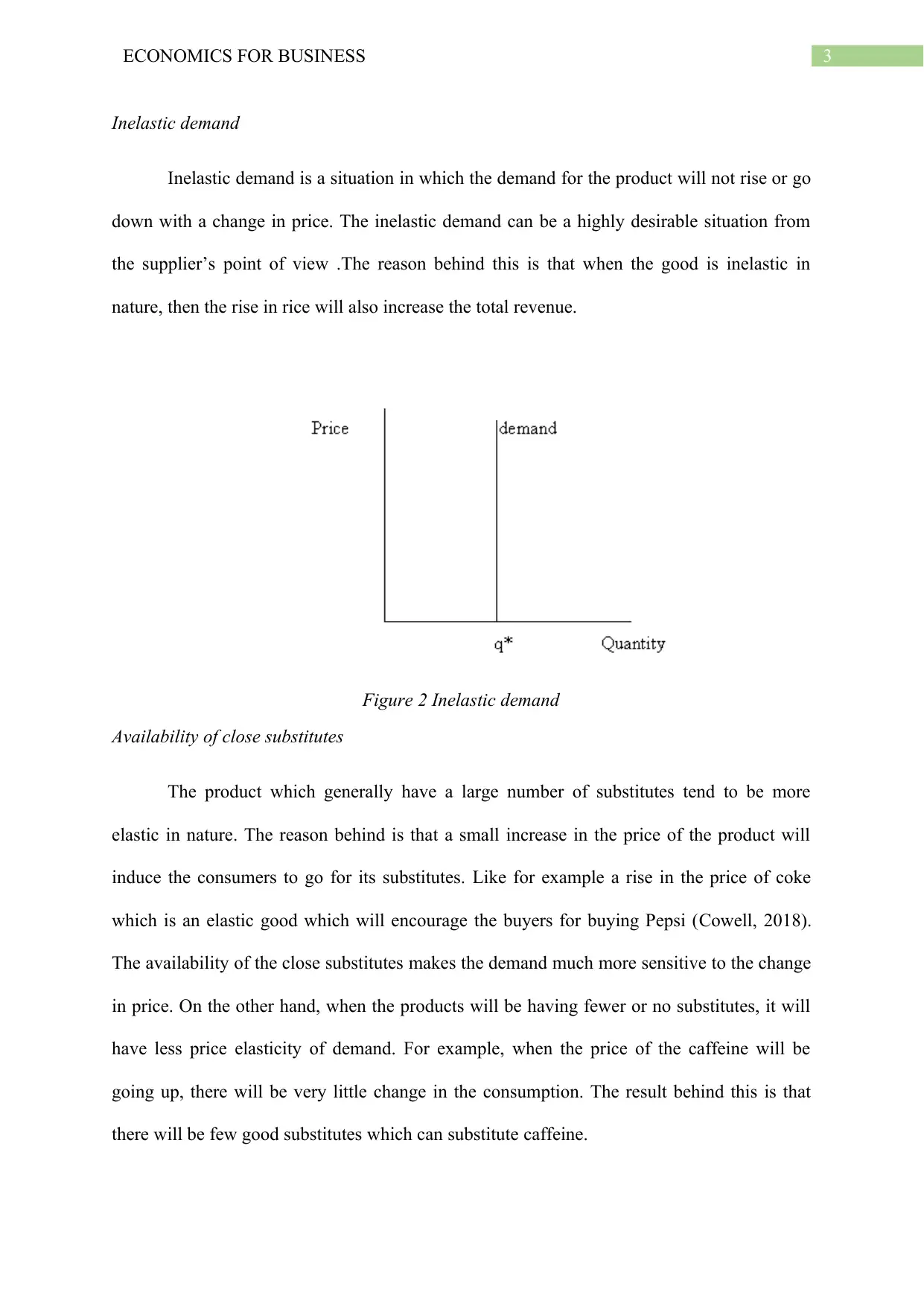
3ECONOMICS FOR BUSINESS
Inelastic demand
Inelastic demand is a situation in which the demand for the product will not rise or go
down with a change in price. The inelastic demand can be a highly desirable situation from
the supplier’s point of view .The reason behind this is that when the good is inelastic in
nature, then the rise in rice will also increase the total revenue.
Figure 2 Inelastic demand
Availability of close substitutes
The product which generally have a large number of substitutes tend to be more
elastic in nature. The reason behind is that a small increase in the price of the product will
induce the consumers to go for its substitutes. Like for example a rise in the price of coke
which is an elastic good which will encourage the buyers for buying Pepsi (Cowell, 2018).
The availability of the close substitutes makes the demand much more sensitive to the change
in price. On the other hand, when the products will be having fewer or no substitutes, it will
have less price elasticity of demand. For example, when the price of the caffeine will be
going up, there will be very little change in the consumption. The result behind this is that
there will be few good substitutes which can substitute caffeine.
Inelastic demand
Inelastic demand is a situation in which the demand for the product will not rise or go
down with a change in price. The inelastic demand can be a highly desirable situation from
the supplier’s point of view .The reason behind this is that when the good is inelastic in
nature, then the rise in rice will also increase the total revenue.
Figure 2 Inelastic demand
Availability of close substitutes
The product which generally have a large number of substitutes tend to be more
elastic in nature. The reason behind is that a small increase in the price of the product will
induce the consumers to go for its substitutes. Like for example a rise in the price of coke
which is an elastic good which will encourage the buyers for buying Pepsi (Cowell, 2018).
The availability of the close substitutes makes the demand much more sensitive to the change
in price. On the other hand, when the products will be having fewer or no substitutes, it will
have less price elasticity of demand. For example, when the price of the caffeine will be
going up, there will be very little change in the consumption. The result behind this is that
there will be few good substitutes which can substitute caffeine.
Paraphrase This Document
Need a fresh take? Get an instant paraphrase of this document with our AI Paraphraser
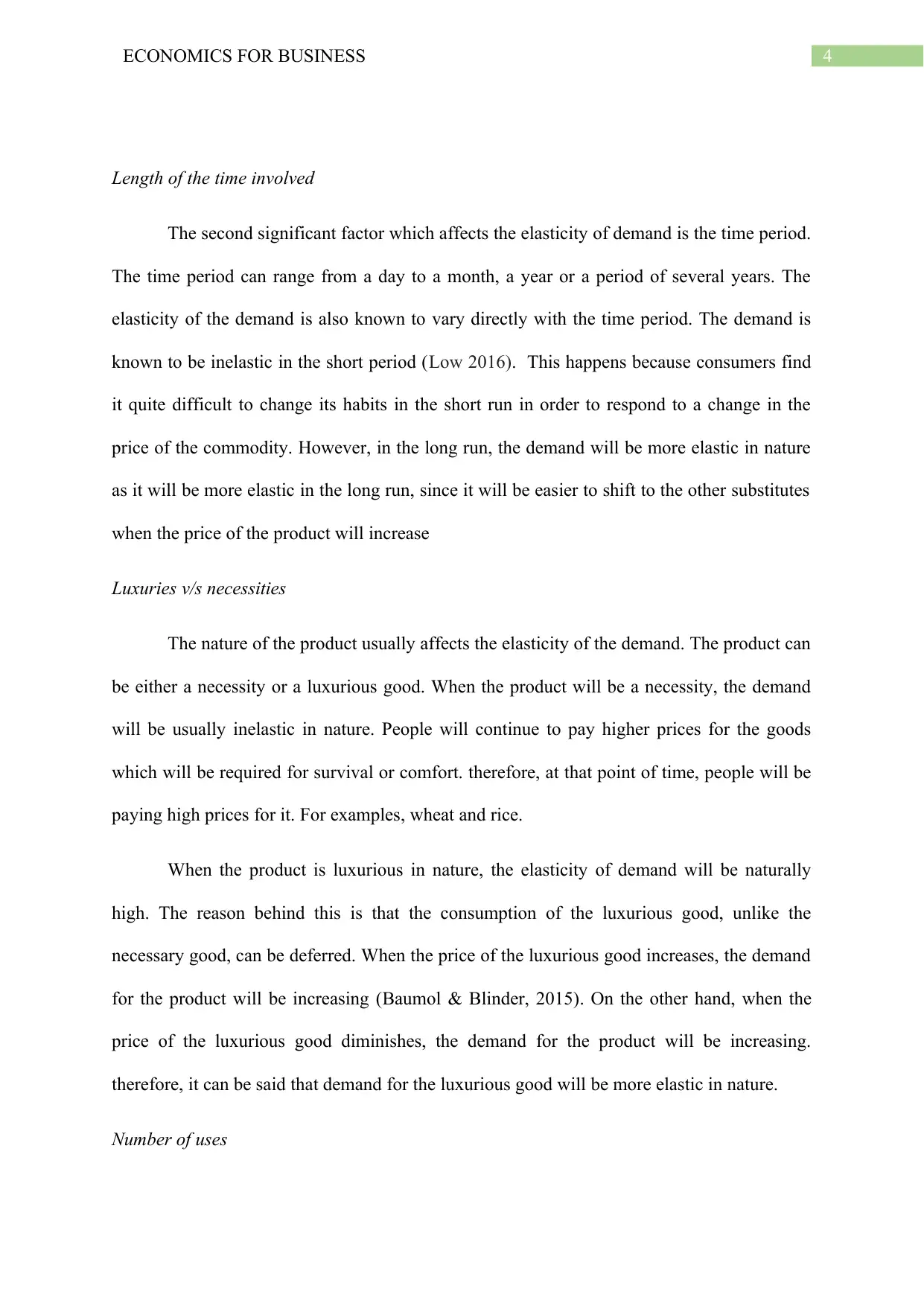
4ECONOMICS FOR BUSINESS
Length of the time involved
The second significant factor which affects the elasticity of demand is the time period.
The time period can range from a day to a month, a year or a period of several years. The
elasticity of the demand is also known to vary directly with the time period. The demand is
known to be inelastic in the short period (Low 2016). This happens because consumers find
it quite difficult to change its habits in the short run in order to respond to a change in the
price of the commodity. However, in the long run, the demand will be more elastic in nature
as it will be more elastic in the long run, since it will be easier to shift to the other substitutes
when the price of the product will increase
Luxuries v/s necessities
The nature of the product usually affects the elasticity of the demand. The product can
be either a necessity or a luxurious good. When the product will be a necessity, the demand
will be usually inelastic in nature. People will continue to pay higher prices for the goods
which will be required for survival or comfort. therefore, at that point of time, people will be
paying high prices for it. For examples, wheat and rice.
When the product is luxurious in nature, the elasticity of demand will be naturally
high. The reason behind this is that the consumption of the luxurious good, unlike the
necessary good, can be deferred. When the price of the luxurious good increases, the demand
for the product will be increasing (Baumol & Blinder, 2015). On the other hand, when the
price of the luxurious good diminishes, the demand for the product will be increasing.
therefore, it can be said that demand for the luxurious good will be more elastic in nature.
Number of uses
Length of the time involved
The second significant factor which affects the elasticity of demand is the time period.
The time period can range from a day to a month, a year or a period of several years. The
elasticity of the demand is also known to vary directly with the time period. The demand is
known to be inelastic in the short period (Low 2016). This happens because consumers find
it quite difficult to change its habits in the short run in order to respond to a change in the
price of the commodity. However, in the long run, the demand will be more elastic in nature
as it will be more elastic in the long run, since it will be easier to shift to the other substitutes
when the price of the product will increase
Luxuries v/s necessities
The nature of the product usually affects the elasticity of the demand. The product can
be either a necessity or a luxurious good. When the product will be a necessity, the demand
will be usually inelastic in nature. People will continue to pay higher prices for the goods
which will be required for survival or comfort. therefore, at that point of time, people will be
paying high prices for it. For examples, wheat and rice.
When the product is luxurious in nature, the elasticity of demand will be naturally
high. The reason behind this is that the consumption of the luxurious good, unlike the
necessary good, can be deferred. When the price of the luxurious good increases, the demand
for the product will be increasing (Baumol & Blinder, 2015). On the other hand, when the
price of the luxurious good diminishes, the demand for the product will be increasing.
therefore, it can be said that demand for the luxurious good will be more elastic in nature.
Number of uses
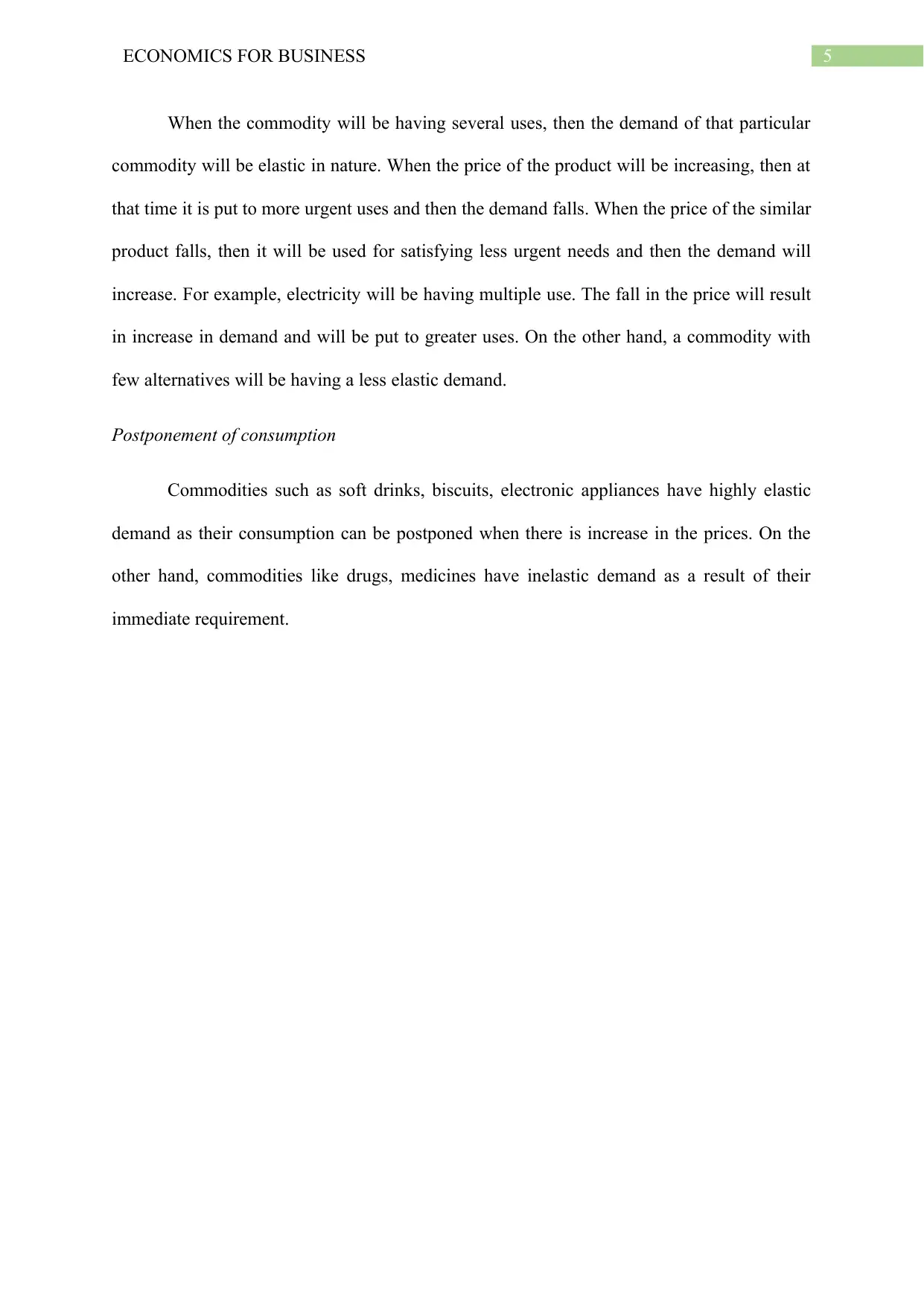
5ECONOMICS FOR BUSINESS
When the commodity will be having several uses, then the demand of that particular
commodity will be elastic in nature. When the price of the product will be increasing, then at
that time it is put to more urgent uses and then the demand falls. When the price of the similar
product falls, then it will be used for satisfying less urgent needs and then the demand will
increase. For example, electricity will be having multiple use. The fall in the price will result
in increase in demand and will be put to greater uses. On the other hand, a commodity with
few alternatives will be having a less elastic demand.
Postponement of consumption
Commodities such as soft drinks, biscuits, electronic appliances have highly elastic
demand as their consumption can be postponed when there is increase in the prices. On the
other hand, commodities like drugs, medicines have inelastic demand as a result of their
immediate requirement.
When the commodity will be having several uses, then the demand of that particular
commodity will be elastic in nature. When the price of the product will be increasing, then at
that time it is put to more urgent uses and then the demand falls. When the price of the similar
product falls, then it will be used for satisfying less urgent needs and then the demand will
increase. For example, electricity will be having multiple use. The fall in the price will result
in increase in demand and will be put to greater uses. On the other hand, a commodity with
few alternatives will be having a less elastic demand.
Postponement of consumption
Commodities such as soft drinks, biscuits, electronic appliances have highly elastic
demand as their consumption can be postponed when there is increase in the prices. On the
other hand, commodities like drugs, medicines have inelastic demand as a result of their
immediate requirement.
⊘ This is a preview!⊘
Do you want full access?
Subscribe today to unlock all pages.

Trusted by 1+ million students worldwide
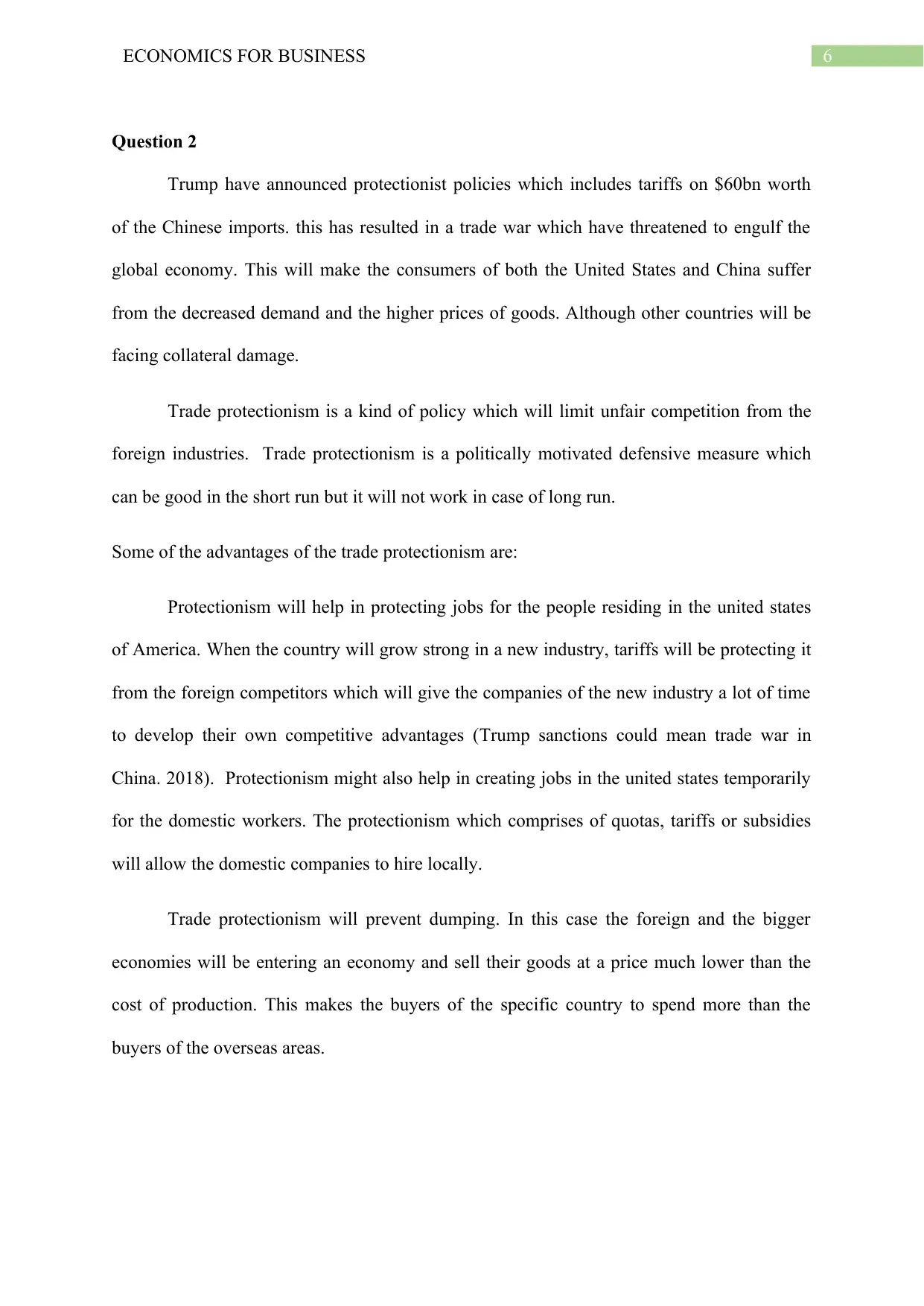
6ECONOMICS FOR BUSINESS
Question 2
Trump have announced protectionist policies which includes tariffs on $60bn worth
of the Chinese imports. this has resulted in a trade war which have threatened to engulf the
global economy. This will make the consumers of both the United States and China suffer
from the decreased demand and the higher prices of goods. Although other countries will be
facing collateral damage.
Trade protectionism is a kind of policy which will limit unfair competition from the
foreign industries. Trade protectionism is a politically motivated defensive measure which
can be good in the short run but it will not work in case of long run.
Some of the advantages of the trade protectionism are:
Protectionism will help in protecting jobs for the people residing in the united states
of America. When the country will grow strong in a new industry, tariffs will be protecting it
from the foreign competitors which will give the companies of the new industry a lot of time
to develop their own competitive advantages (Trump sanctions could mean trade war in
China. 2018). Protectionism might also help in creating jobs in the united states temporarily
for the domestic workers. The protectionism which comprises of quotas, tariffs or subsidies
will allow the domestic companies to hire locally.
Trade protectionism will prevent dumping. In this case the foreign and the bigger
economies will be entering an economy and sell their goods at a price much lower than the
cost of production. This makes the buyers of the specific country to spend more than the
buyers of the overseas areas.
Question 2
Trump have announced protectionist policies which includes tariffs on $60bn worth
of the Chinese imports. this has resulted in a trade war which have threatened to engulf the
global economy. This will make the consumers of both the United States and China suffer
from the decreased demand and the higher prices of goods. Although other countries will be
facing collateral damage.
Trade protectionism is a kind of policy which will limit unfair competition from the
foreign industries. Trade protectionism is a politically motivated defensive measure which
can be good in the short run but it will not work in case of long run.
Some of the advantages of the trade protectionism are:
Protectionism will help in protecting jobs for the people residing in the united states
of America. When the country will grow strong in a new industry, tariffs will be protecting it
from the foreign competitors which will give the companies of the new industry a lot of time
to develop their own competitive advantages (Trump sanctions could mean trade war in
China. 2018). Protectionism might also help in creating jobs in the united states temporarily
for the domestic workers. The protectionism which comprises of quotas, tariffs or subsidies
will allow the domestic companies to hire locally.
Trade protectionism will prevent dumping. In this case the foreign and the bigger
economies will be entering an economy and sell their goods at a price much lower than the
cost of production. This makes the buyers of the specific country to spend more than the
buyers of the overseas areas.
Paraphrase This Document
Need a fresh take? Get an instant paraphrase of this document with our AI Paraphraser
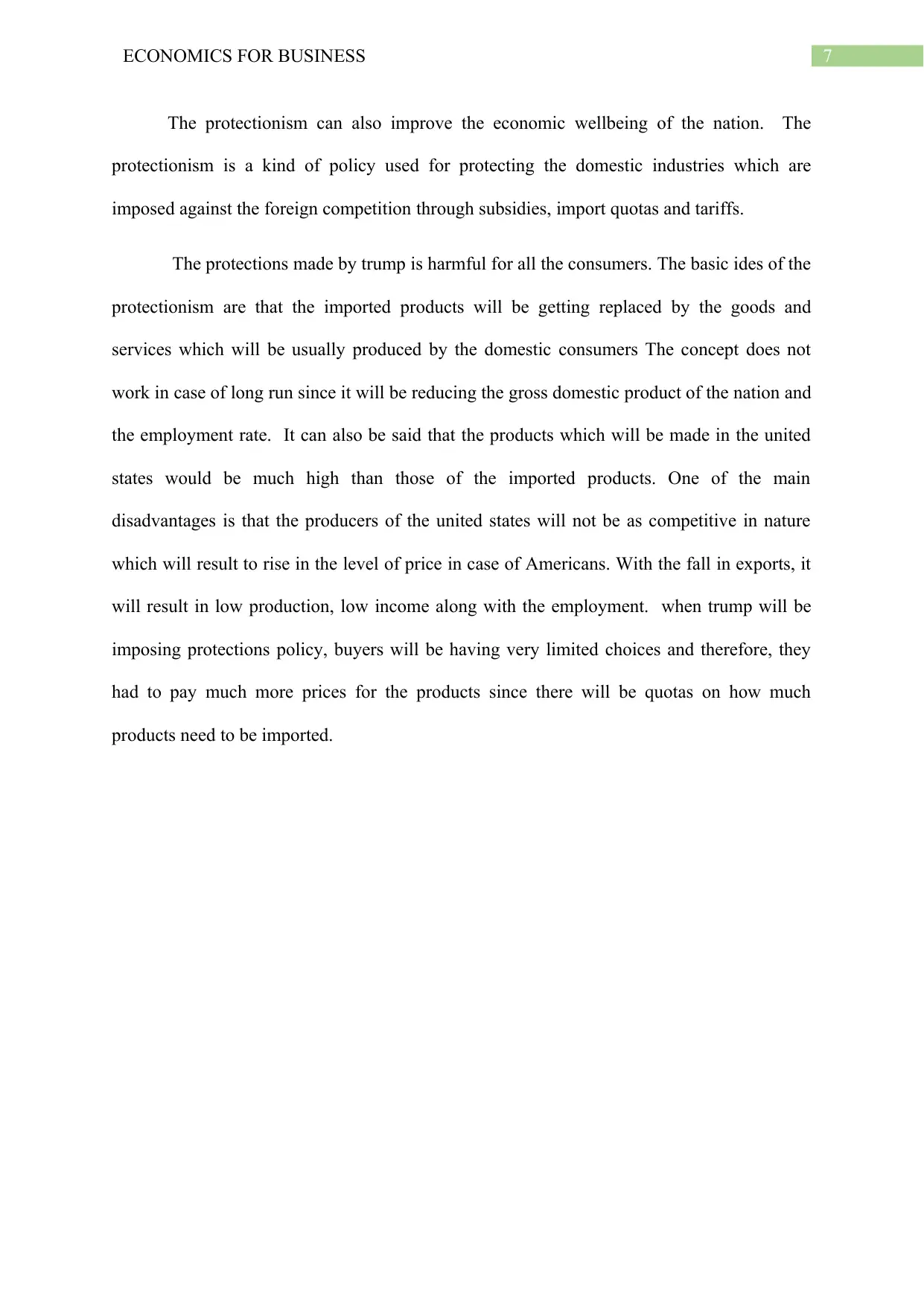
7ECONOMICS FOR BUSINESS
The protectionism can also improve the economic wellbeing of the nation. The
protectionism is a kind of policy used for protecting the domestic industries which are
imposed against the foreign competition through subsidies, import quotas and tariffs.
The protections made by trump is harmful for all the consumers. The basic ides of the
protectionism are that the imported products will be getting replaced by the goods and
services which will be usually produced by the domestic consumers The concept does not
work in case of long run since it will be reducing the gross domestic product of the nation and
the employment rate. It can also be said that the products which will be made in the united
states would be much high than those of the imported products. One of the main
disadvantages is that the producers of the united states will not be as competitive in nature
which will result to rise in the level of price in case of Americans. With the fall in exports, it
will result in low production, low income along with the employment. when trump will be
imposing protections policy, buyers will be having very limited choices and therefore, they
had to pay much more prices for the products since there will be quotas on how much
products need to be imported.
The protectionism can also improve the economic wellbeing of the nation. The
protectionism is a kind of policy used for protecting the domestic industries which are
imposed against the foreign competition through subsidies, import quotas and tariffs.
The protections made by trump is harmful for all the consumers. The basic ides of the
protectionism are that the imported products will be getting replaced by the goods and
services which will be usually produced by the domestic consumers The concept does not
work in case of long run since it will be reducing the gross domestic product of the nation and
the employment rate. It can also be said that the products which will be made in the united
states would be much high than those of the imported products. One of the main
disadvantages is that the producers of the united states will not be as competitive in nature
which will result to rise in the level of price in case of Americans. With the fall in exports, it
will result in low production, low income along with the employment. when trump will be
imposing protections policy, buyers will be having very limited choices and therefore, they
had to pay much more prices for the products since there will be quotas on how much
products need to be imported.
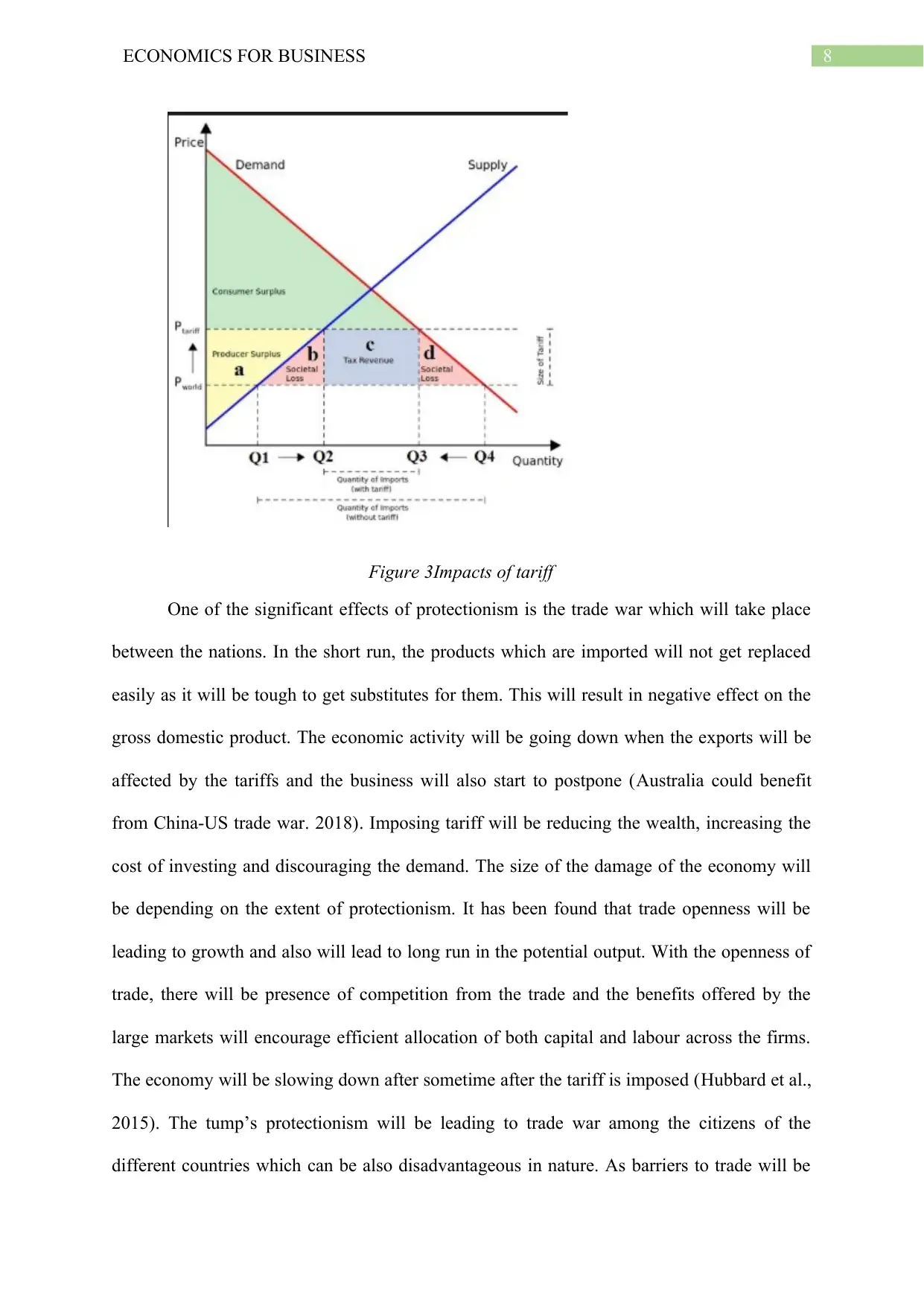
8ECONOMICS FOR BUSINESS
Figure 3Impacts of tariff
One of the significant effects of protectionism is the trade war which will take place
between the nations. In the short run, the products which are imported will not get replaced
easily as it will be tough to get substitutes for them. This will result in negative effect on the
gross domestic product. The economic activity will be going down when the exports will be
affected by the tariffs and the business will also start to postpone (Australia could benefit
from China-US trade war. 2018). Imposing tariff will be reducing the wealth, increasing the
cost of investing and discouraging the demand. The size of the damage of the economy will
be depending on the extent of protectionism. It has been found that trade openness will be
leading to growth and also will lead to long run in the potential output. With the openness of
trade, there will be presence of competition from the trade and the benefits offered by the
large markets will encourage efficient allocation of both capital and labour across the firms.
The economy will be slowing down after sometime after the tariff is imposed (Hubbard et al.,
2015). The tump’s protectionism will be leading to trade war among the citizens of the
different countries which can be also disadvantageous in nature. As barriers to trade will be
Figure 3Impacts of tariff
One of the significant effects of protectionism is the trade war which will take place
between the nations. In the short run, the products which are imported will not get replaced
easily as it will be tough to get substitutes for them. This will result in negative effect on the
gross domestic product. The economic activity will be going down when the exports will be
affected by the tariffs and the business will also start to postpone (Australia could benefit
from China-US trade war. 2018). Imposing tariff will be reducing the wealth, increasing the
cost of investing and discouraging the demand. The size of the damage of the economy will
be depending on the extent of protectionism. It has been found that trade openness will be
leading to growth and also will lead to long run in the potential output. With the openness of
trade, there will be presence of competition from the trade and the benefits offered by the
large markets will encourage efficient allocation of both capital and labour across the firms.
The economy will be slowing down after sometime after the tariff is imposed (Hubbard et al.,
2015). The tump’s protectionism will be leading to trade war among the citizens of the
different countries which can be also disadvantageous in nature. As barriers to trade will be
⊘ This is a preview!⊘
Do you want full access?
Subscribe today to unlock all pages.

Trusted by 1+ million students worldwide
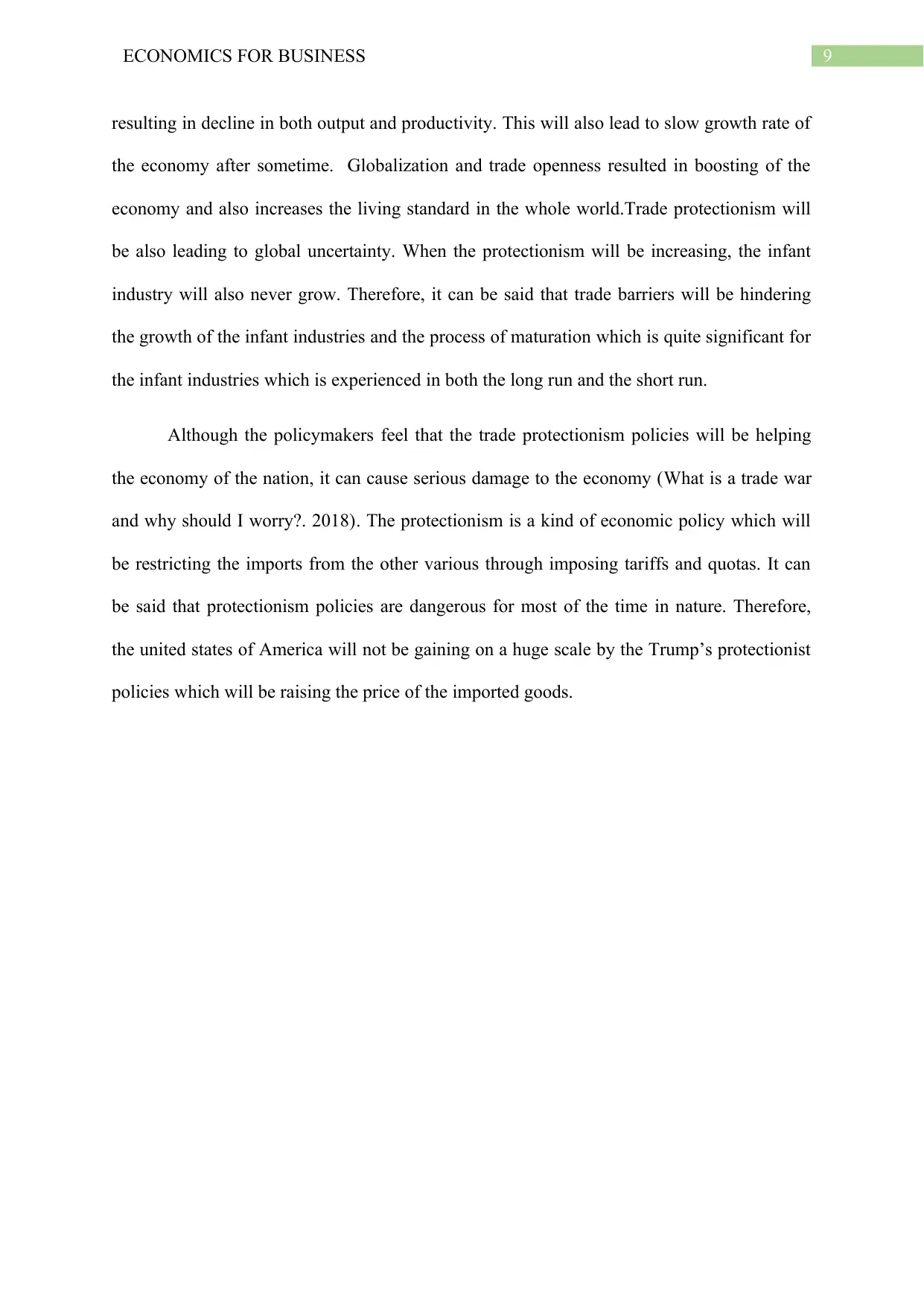
9ECONOMICS FOR BUSINESS
resulting in decline in both output and productivity. This will also lead to slow growth rate of
the economy after sometime. Globalization and trade openness resulted in boosting of the
economy and also increases the living standard in the whole world.Trade protectionism will
be also leading to global uncertainty. When the protectionism will be increasing, the infant
industry will also never grow. Therefore, it can be said that trade barriers will be hindering
the growth of the infant industries and the process of maturation which is quite significant for
the infant industries which is experienced in both the long run and the short run.
Although the policymakers feel that the trade protectionism policies will be helping
the economy of the nation, it can cause serious damage to the economy (What is a trade war
and why should I worry?. 2018). The protectionism is a kind of economic policy which will
be restricting the imports from the other various through imposing tariffs and quotas. It can
be said that protectionism policies are dangerous for most of the time in nature. Therefore,
the united states of America will not be gaining on a huge scale by the Trump’s protectionist
policies which will be raising the price of the imported goods.
resulting in decline in both output and productivity. This will also lead to slow growth rate of
the economy after sometime. Globalization and trade openness resulted in boosting of the
economy and also increases the living standard in the whole world.Trade protectionism will
be also leading to global uncertainty. When the protectionism will be increasing, the infant
industry will also never grow. Therefore, it can be said that trade barriers will be hindering
the growth of the infant industries and the process of maturation which is quite significant for
the infant industries which is experienced in both the long run and the short run.
Although the policymakers feel that the trade protectionism policies will be helping
the economy of the nation, it can cause serious damage to the economy (What is a trade war
and why should I worry?. 2018). The protectionism is a kind of economic policy which will
be restricting the imports from the other various through imposing tariffs and quotas. It can
be said that protectionism policies are dangerous for most of the time in nature. Therefore,
the united states of America will not be gaining on a huge scale by the Trump’s protectionist
policies which will be raising the price of the imported goods.
Paraphrase This Document
Need a fresh take? Get an instant paraphrase of this document with our AI Paraphraser
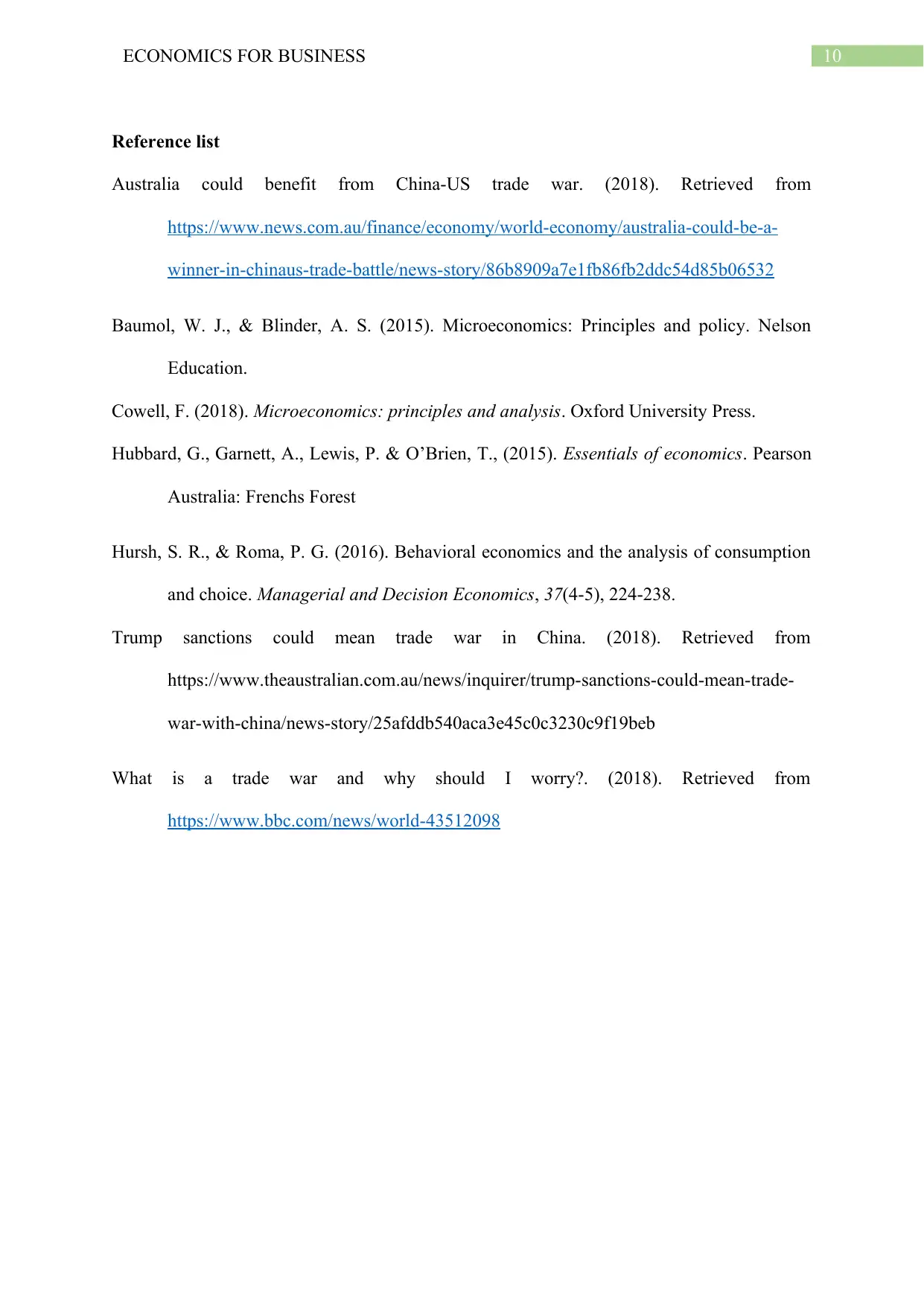
10ECONOMICS FOR BUSINESS
Reference list
Australia could benefit from China-US trade war. (2018). Retrieved from
https://www.news.com.au/finance/economy/world-economy/australia-could-be-a-
winner-in-chinaus-trade-battle/news-story/86b8909a7e1fb86fb2ddc54d85b06532
Baumol, W. J., & Blinder, A. S. (2015). Microeconomics: Principles and policy. Nelson
Education.
Cowell, F. (2018). Microeconomics: principles and analysis. Oxford University Press.
Hubbard, G., Garnett, A., Lewis, P. & O’Brien, T., (2015). Essentials of economics. Pearson
Australia: Frenchs Forest
Hursh, S. R., & Roma, P. G. (2016). Behavioral economics and the analysis of consumption
and choice. Managerial and Decision Economics, 37(4-5), 224-238.
Trump sanctions could mean trade war in China. (2018). Retrieved from
https://www.theaustralian.com.au/news/inquirer/trump-sanctions-could-mean-trade-
war-with-china/news-story/25afddb540aca3e45c0c3230c9f19beb
What is a trade war and why should I worry?. (2018). Retrieved from
https://www.bbc.com/news/world-43512098
Reference list
Australia could benefit from China-US trade war. (2018). Retrieved from
https://www.news.com.au/finance/economy/world-economy/australia-could-be-a-
winner-in-chinaus-trade-battle/news-story/86b8909a7e1fb86fb2ddc54d85b06532
Baumol, W. J., & Blinder, A. S. (2015). Microeconomics: Principles and policy. Nelson
Education.
Cowell, F. (2018). Microeconomics: principles and analysis. Oxford University Press.
Hubbard, G., Garnett, A., Lewis, P. & O’Brien, T., (2015). Essentials of economics. Pearson
Australia: Frenchs Forest
Hursh, S. R., & Roma, P. G. (2016). Behavioral economics and the analysis of consumption
and choice. Managerial and Decision Economics, 37(4-5), 224-238.
Trump sanctions could mean trade war in China. (2018). Retrieved from
https://www.theaustralian.com.au/news/inquirer/trump-sanctions-could-mean-trade-
war-with-china/news-story/25afddb540aca3e45c0c3230c9f19beb
What is a trade war and why should I worry?. (2018). Retrieved from
https://www.bbc.com/news/world-43512098
1 out of 11
Related Documents
Your All-in-One AI-Powered Toolkit for Academic Success.
+13062052269
info@desklib.com
Available 24*7 on WhatsApp / Email
![[object Object]](/_next/static/media/star-bottom.7253800d.svg)
Unlock your academic potential
Copyright © 2020–2025 A2Z Services. All Rights Reserved. Developed and managed by ZUCOL.





